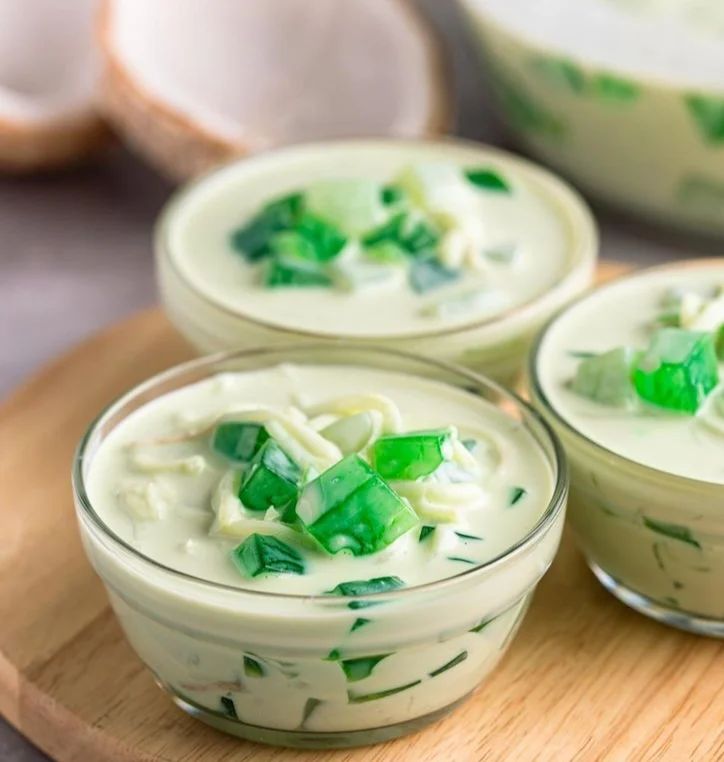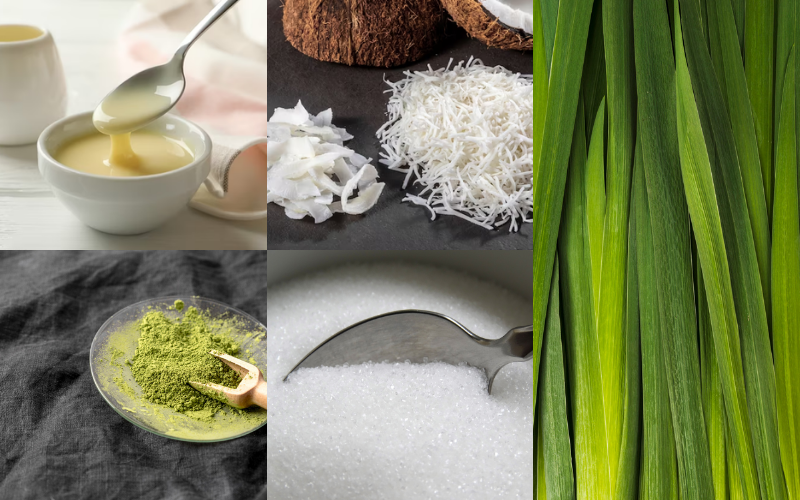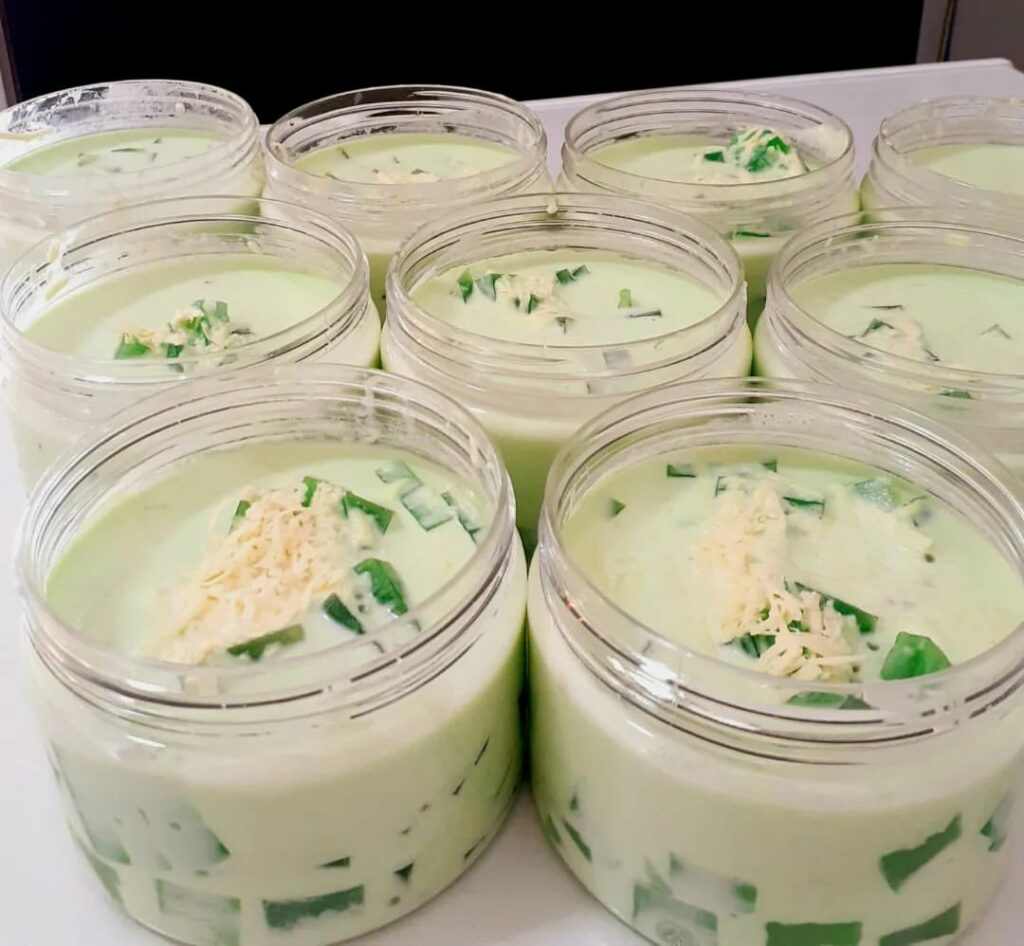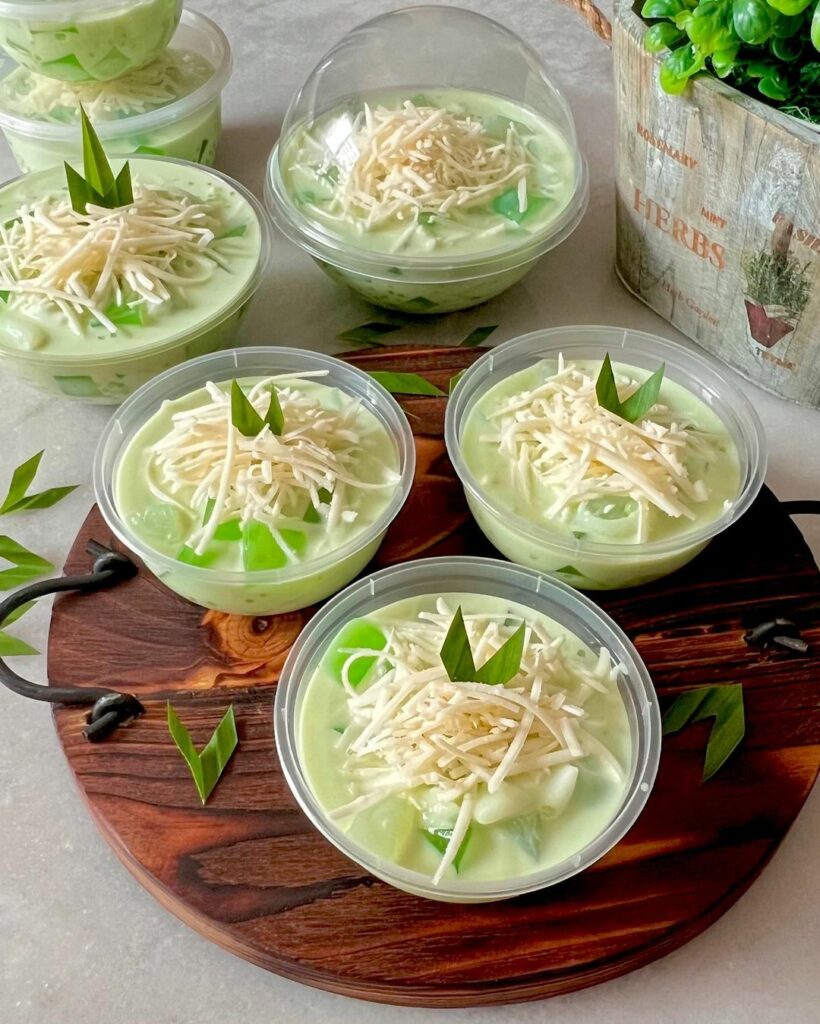I vividly remember my first taste of Buko Pandan during my travels in the Philippines. The refreshing coconut and pandan dessert Filipino of the desert was a perfect antidote to the hot and humid weather. I was so captivated by its taste that I decided to learn how to make it myself. After many attempts and experiments, I finally perfected the recipe.
In this article, I’ll share my personal experience and guide you through the process of making the best Buko Pandan recipe that you and your guests will love.
What’s buko pandan?

Pandan dessert Filipino is a popular Filipino dessert made with young coconut meat, pandan leaves, and gelatin. Its origin can be traced back to the southern part of the Philippines, where coconuts and pandan leaves are abundant. The dessert gained popularity across the country and has since become a staple in Filipino cuisine, often served at special occasions such as fiestas and holidays.
Buko Pandan has evolved over time, and many variations have emerged, each with its unique twist. Some popular variations include Buko Pandan salad, which includes fruits like apples and grapes, and Buko Pandan ice cream, a frozen version of the dessert. Despite the variations, the essence of Buko Pandan remains the same – a sweet and refreshing dessert that celebrates the tropical flavors of the Philippines.
What is buko pandan made of?
Buko Pandan is a dessert made with young coconut meat, pandan leaves, and gelatin. The buko meat is shredded and mixed with the gelatin, which is made from boiling water, sugar, and agar-agar or gulaman. Pandan leaves are used to extract the juice, which is added to the mixture to give it a distinct aroma and flavor.
The dessert is typically served chilled and can be garnished with additional buko meat or grated cheese. Some variations may also include other fruits like apples and grapes or additional ingredients like evaporated milk or cream cheese.
What does buko pandan taste like?
Buko Pandan has a unique and refreshing taste that combines the sweet and creamy flavor of young coconut meat with the distinct aroma and flavor of pandan leaves. The dessert is also slightly chewy due to the gelatin used in the recipe.
The taste can vary depending on the recipe, with some versions being more sweet or creamy than others. Buko Pandan is often served chilled, making it a perfect dessert to cool down on a hot day.
Buko pandan recipe

Chill the dessert for at least 2 hours before serving.
Cooking note
- Yield: 8–10 servings
- Prep Time: 20 minutes
- Cook Time: 20 minutes
- Total Time: 2 hours and 40 minutes
- Course: Dessert
- Cuisine: Filipino
- Equipment: Mixing bowl, saucepan, strainer, measuring cups and spoons, shredder, knife
Buko pandan ingredients
- 2 cups young coconut meat, shredded
- 1 pack (25g) pandan leaves
- 1 pack (25g) unflavored green gelatin powder
- 1 can (14 oz) evaporated milk
- 1 ¾ cups water
- ½ cup sugar
How to make buko pandan?
Making Buko Pandan looks simple and takes quite a bit of time, but it will have many steps for you to make the finished product, don’t skip the steps below.
Step-by-step guide on preparing the buko meat
- Crack open 2 young coconuts and remove the white meat using a shredder or a knife.
- Rinse the shredded meat in cold water to remove any impurities.
- Squeeze the excess water out of the shredded meat using a cheesecloth or a clean kitchen towel.
- Set aside the shredded buko meat in a mixing bowl.
How to extract pandan juice from pandan leaves
- Wash 25g of pandan leaves and cut them into small pieces.
- Put the pandan leaves into a blender or food processor.
- Add 1 cup of water and blend until the leaves are finely chopped.
- Strain the mixture using a cheesecloth or a fine mesh strainer to extract the juice.
- Discard the pandan leaves and set aside the juice.
How to make pandan essence
- In a small saucepan, combine ½ cup of water and ½ cup of sugar.
- Heat the mixture over low heat and stir until the sugar dissolves.
- Add the pandan juice and stir until well combined.
- Bring the mixture to a boil and let it simmer for 2-3 minutes.
- Remove the saucepan from the heat and let the mixture cool.
- Once cooled, transfer the mixture into a clean container and store it in the refrigerator.
Mixing the buko pandan
- In a separate saucepan, dissolve 1 pack of unflavored green gelatin powder in ¾ cup of water.
- Add 1 can of evaporated milk and ¾ cup of pandan juice to the mixture.
- Heat the mixture over low heat and stir until well combined.
- Remove the saucepan from the heat and let the mixture cool.
- Once cooled, add the shredded buko meat to the mixture and stir until well combined.
- Pour the mixture into a large container or mold.
- Chill the dessert in the refrigerator for at least 2 hours.
- Once chilled, slice the Buko Pandan and serve.
Common mistakes to avoid in making the buko pandan
Common mistakes to avoid in making Buko Pandan
- Using mature or old coconuts: This can result in tough and chewy buko meat, which can affect the overall texture of the dessert.
- Not properly squeezing the buko meat: If the buko meat is not properly squeezed, excess water can cause the desert to become runny and affect the texture.
- Overheating the pandan juice: Heating the pandan juice for too long or at high temperatures can cause the juice to become bitter and affect the flavor of the desert.
- Using too much or too little gelatin: Using too much gelatin can make the dessert too firm while using too little can make it too soft.
- Not chilling the dessert for long enough: Chilling the dessert for less than 2 hours can result in a runny or watery texture, which can affect the overall quality of the dessert.
- Not following the recipe: Buko Pandan is a delicate dessert, and any variations or changes to the recipe can significantly affect the taste and texture. It’s essential to follow the recipe closely to achieve the best results.
Tips and tricks to make perfect buko pandan

To get the finished Buko Pandan I’ll give you some tips and tricks to make it an easy recipe at home.
- Use fresh ingredients: Select the freshest young coconuts and pandan leaves for the best flavor and texture.
- Properly squeeze the buko meat: Squeeze out the excess water from the shredded buko meat to prevent the dessert from becoming too watery.
- Strain the pandan juice properly: Use a fine mesh strainer or a cheesecloth to extract the juice from the pandan leaves and remove any debris.
- Adjust the sweetness: Taste the mixture as you go and adjust the sweetness level to your preference by adding more or less condensed milk or sugar.
- Use the right amount of gelatin: Follow the recipe for the recommended amount of gelatin powder to achieve the perfect texture.
- Chill the dessert for at least 2 hours: Allow enough time for the dessert to be set in the refrigerator for at least 2 hours before serving.
- Add toppings or garnishes: Add grated cheese or additional buko meat as a topping to enhance the flavor and presentation of the dessert.
- Experiment with variations: Add other fruits or ingredients to the mixture to create your own unique twist on the classic Buko Pandan recipe.
- Practice and patience: Making Buko Pandan requires practice and patience. Don’t be discouraged if it doesn’t turn out perfect the first time, keep trying until you achieve the desired taste and texture.
Table about nutrient facts of buko pandan
Nutrition Facts of Buko Pandan
| Nutrient | Amount per serving (100g) |
| Calories | 111 kcal |
| Protein | 1.9 g |
| Total Fat | 4.1 g |
| Carbohydrates | 17.7 g |
| Dietary Fiber | 0.9 g |
| Sugar | 16.8 g |
| Calcium | 51.2 mg |
| Iron | 0.5 mg |
| Potassium | 123 mg |
| Sodium | 18.3 mg |
Note: The nutrient content may vary depending on the specific recipe and ingredients used.
What to serve with buko pandan?
Buko Pandan is a delicious dessert that can be served on its own or with a variety of accompaniments. Some popular options include:
- Fresh fruits: Serve Buko Pandan with fresh fruits like mangoes, bananas, or strawberries to add a burst of flavor and color to the dessert.
- Whipped cream: Top the Buko Pandan with whipped cream for an extra creamy and decadent touch.
- Ice cream: Serve Buko Pandan alongside a scoop of coconut or vanilla ice cream for a cool and refreshing treat.
- Toasted coconut flakes: Sprinkle toasted coconut flakes on top of the Buko Pandan to add a crunchy texture and enhance the coconut flavor.
Buko Pandan is best served chilled. After the dessert has been set in the refrigerator for at least 2 hours, slice it into serving portions and transfer it onto a platter or individual serving dishes.
Garnish with additional buko meat or grated cheese, if desired. Serve the dessert alongside any accompaniments you prefer, and enjoy!
Variations of buko pandan
Buko Pandan is a versatile dessert that can be customized with various ingredients and variations. Here are some popular variations of Buko Pandan:
- Buko Pandan with Coconut Milk: Substitute the condensed milk with coconut milk for a richer and more coconutty flavor. Use the same amount of coconut milk as condensed milk.
- Buko Pandan with Cream Cheese: Add 4 oz of softened cream cheese to the mixture for a tangy and creamy twist on the classic recipe.
- Vegan and Gluten-Free Buko Pandan: Replace the gelatin with agar-agar or carrageenan to make the dessert vegan. Use gluten-free gelatin or agar-agar to make it gluten-free.
List of alternative ingredients for buko pandan

If you want to experiment with the flavor of Buko Pandan or make it more accessible for people with allergies or dietary restrictions, here are some alternative ingredients you can use:
- Pandan extract: If you can’t find fresh pandan leaves, you can use pandan extract as a substitute. It’s available in some Asian grocery stores or online.
- Coconut cream: For a richer and creamier Buko Pandan, you can use coconut cream instead of coconut milk.
- Brown sugar: If you prefer a deeper and more caramelized flavor, you can use brown sugar instead of white sugar.
- Honey or maple syrup: To make the dessert healthier, you can use honey or maple syrup as a natural sweetener.
- Fresh fruits: You can add different kinds of fruits to the Buko Pandan mixture, such as mango, pineapple, or strawberries, to give it a more fruity flavor and texture.
- Cream cheese: For a creamier and tangier Buko Pandan, you can add cream cheese to the mixture.
- Almond milk: If you are lactose intolerant or vegan, you can use almond milk instead of regular milk.
- Agar-agar: For a vegetarian or vegan version of Buko Pandan, you can use agar-agar instead of gelatin.
- Gluten-free flour: If you have a gluten allergy, you can use gluten-free flour instead of regular flour in the recipe.
How to store buko pandan?
Buko Pandan is best stored in the refrigerator to maintain its texture and flavor. Here’s how to store it properly:
- After slicing the Buko Pandan into serving portions, transfer them to an airtight container or cover them with plastic wrap.
- Store the container in the refrigerator for up to 2–3 days.
- If you want to store the dessert for a longer period, freeze it in an airtight container for up to 1–2 weeks.
- To prevent freezer burn, wrap the container with plastic wrap or aluminum foil before freezing.
- Thaw the Buko Pandan in the refrigerator before serving.
- In addition, if you want to Remove the Buko Pandan from the refrigerator and allow it to come to room temperature for about 30 minutes.
- Place the Buko Pandan in a microwave-safe dish and cover it with a damp paper towel.
- Microwave the dessert on medium heat for 30-second intervals until it’s heated through.
However, the texture and quality may start to deteriorate after 2–3 days. To ensure the best taste and texture, it’s recommended to consume the dessert within the first 2 days of making it.
FAQs
What is the best type of coconut to use in buko pandan?
The best type of coconut to use in Buko Pandan is young coconut, or “buko” in Filipino. It has a tender and jelly-like texture that complements the gelatinous and creamy texture of the dessert.
Using mature coconuts can result in tough and chewy buko meat, which can affect the overall texture and flavor of the dessert.
How do I know if the gelatin is cooked?
To check if the gelatin is cooked, you can perform the “spoon test.” Dip a spoon into the mixture and lift it up. The gelatin mixture should coat the spoon and not run off. If the mixture is still too runny, it means the gelatin is not cooked yet and needs more time to set.
Can I use frozen coconut meat for buko pandan?
Yes, you can use frozen coconut meat for Buko Pandan. Thaw the frozen coconut meat in the refrigerator overnight and squeeze out any excess water before using it in the recipe. Using fresh coconut meat is ideal, but frozen coconut meat can be a good substitute if fresh is not available.
How do I extract pandan juice from pandan leaves?
- Cut the pandan leaves into small pieces using scissors or a sharp knife.
- Add the pandan leaves and ½ cup of water to a blender or food processor.
- Blend the pandan leaves and water until the leaves are finely chopped and the water turns green.
- Pour the mixture into a cheesecloth or fine mesh strainer and squeeze out the juice.
- Store the pandan juice in a small container until ready to use.
Can I make buko pandan in advance?
Yes, you can make Buko Pandan in advance. After preparing and cooking the dessert, allow it to cool down to room temperature. Slice the Buko Pandan into serving portions and transfer them to an airtight container or cover them with plastic wrap.
Store the container in the refrigerator for up to 2–3 days. If you want to store the dessert for a longer period, freeze it in an airtight container for up to 1–2 months. To prevent freezer burn, wrap the container with plastic wrap or aluminum foil before freezing. Thaw the Buko Pandan in the refrigerator before serving.
How do I adjust the sweetness level of buko pandan?
To adjust the sweetness level of Buko Pandan, you can add or reduce the amount of sugar in the recipe. Start by using the recommended amount of sugar and taste the mixture.
If you find it too sweet, add more pandan juice or water to dilute the sweetness. If you find it not sweet enough, add more sugar, a little at a time until you reach your desired level of sweetness. You can also use alternative sweeteners, such as honey or maple syrup, to adjust the sweetness level to your liking.
What other fruits can I add to buko pandan?
Buko Pandan is a versatile dessert that can be customized with a variety of fruits. Here are some popular options:
- Mangoes: Add fresh mangoes or mango puree to the Buko Pandan mixture for a sweet and tangy flavor.
- Pineapples: Add canned or fresh pineapple chunks to the Buko Pandan mixture for a tropical twist.
- Strawberries: Add fresh strawberries or strawberry puree to the Buko Pandan mixture for a fruity and colorful dessert.
- Jackfruit: Add canned or fresh jackfruit to the Buko Pandan mixture for a unique and exotic flavor.
- Blueberries: Add fresh blueberries or blueberry puree to the Buko Pandan mixture for a burst of sweetness and antioxidant benefits.
- Bananas: Add sliced or mashed bananas to the Buko Pandan mixture for a creamy and sweet dessert.
Can I add food coloring to buko pandan?
Yes, you can add food coloring to Buko Pandan to enhance its visual appeal. You can use green food coloring to give it a vibrant green color that resembles pandan leaves.
However, if you prefer a natural approach, you can use pandan juice or pandan essence to color the dessert. Simply add a few drops of pandan juice or essence to the mixture until you reach your desired shade of green.
How do I prevent my buko pandan from becoming too runny?
To prevent your Buko Pandan from becoming too runny, here are some tips:
- Use the right amount of gelatin: Make sure to follow the recipe and use the recommended amount of gelatin. Too little gelatin can result in a runny Buko Pandan.
- Chill the mixture properly: After adding the gelatin to the mixture, chill it in the refrigerator until it’s set. Do not rush the process by putting it in the freezer as this can result in a grainy and watery texture.
- Drain the buko meat properly: Before adding the buko meat to the mixture, drain it properly to remove any excess water. This will prevent the mixture from becoming too watery.
- Do not add too much liquid: Be careful when adding liquid ingredients such as milk, coconut milk, or pandan juice. Adding too much liquid can dilute the mixture and make it runny.
Conclusion
Upon analyzing the facts, the Buko Pandan dessert is delicious and refreshing that is popular not only in the Philippines but also around the world. By following the steps outlined in this comprehensive guide, you can now make the perfect Buko Pandan recipe right in your own kitchen.
Remember to use fresh ingredients, take your time in preparing the buko and pandan juice, and experiment with different variations to make it uniquely yours. With a little practice and patience, you’ll be able to impress your family and friends with this classic Filipino dessert. So go ahead and give it a try – I’m sure you’ll enjoy it as much as I do!
More savory pandan recipes
- Japanese Pandan Bread Recipe
- Agar Vietnamese Pandan Jelly (Thach La Dua)